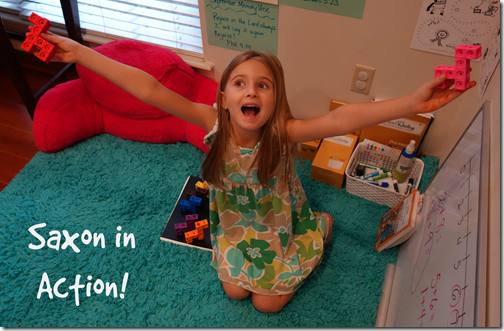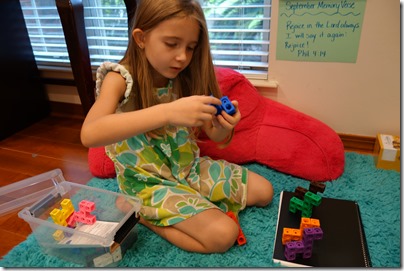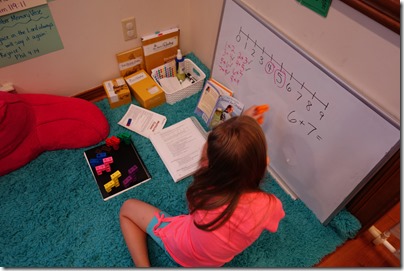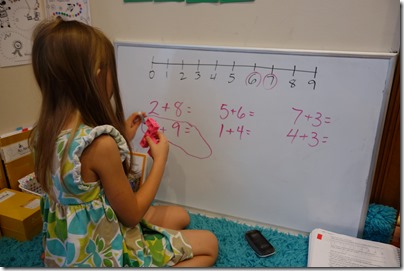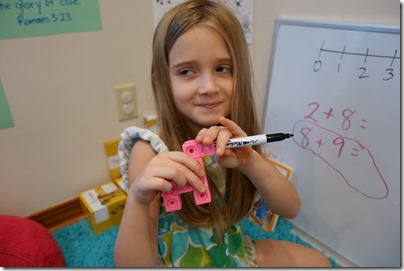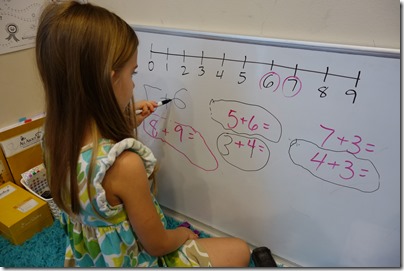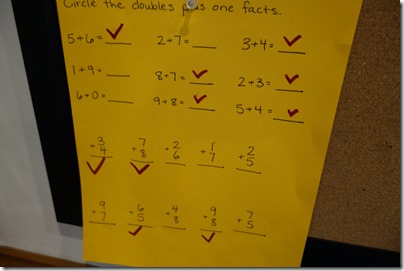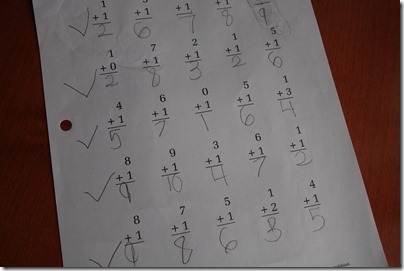Saxon in Action
Sep 28, 2015
When researching curriculum, I like to see it in action. Seeing sample pages from a workbook is nice, but when I can find a post where someone has taken the time to blog about the ins and outs of one particular lesson in the curriculum, I feel like I can get a better feel for whether that curriculum will suit my child and my homeschool.
Here is a play-by-play of a Saxon 1 Math lesson for anyone researching Saxon….and for me to look back on one day and remember what makes Little Bug Little Bug. (You have to chuckle at what motivates this kid.)
Background Info
I am supplementing our core math curriculum (Horizons K) with Saxon 1 for the basic math fact lessons. We are only doing the basic math fact lessons with the Fact Sheets, which is a timed test to help in the memorization of the math facts. We’ve learned the Doubles facts (4+4=8), Plus One facts (4+1+5), Plus Zero facts (4+0=4) and we are currently learning the Doubles Plus One facts (4+5=9).
Lesson 77 In Action
If you are Little Bug, first you make “dogs” from the linking cubes. These dogs will help you answer the questions or they may answer the questions on their own without any assistance from you.
I broke this lesson into two days. The first day we began learning how to identify addition facts called doubles plus one facts. I made two towers of 4 and asked what number sentence we could write for those towers. 4+4=8. Then, I added one linking cube to one of the towers and asked Little Bug to write the number sentence on the board. She wrote 4+5. I told her that is a doubles plus one fact because it started as a double and then we added one more. Next, I drew a number line on the board and told Little Bug to look at numbers 4 and 5 on the number line. Her “dog” looked for her. I asked her (the dog) what she noticed and the dog told me that the numbers are next to each other on the number line. Then, I asked what other number are next to each other on the number line. We made a list of all the combinations. (1+2, 2+3, 3+4, etc..)
Then I told Little Bug and her dog friends that we were going to learn a trick for adding numbers that are next to each other on the number line together. I said we were going to use our doubles to help us. We would double the smallest number. We tried this trick with 6+7 first and you can see below the orange dog was the one figuring this one out!
I asked orange dog which number was the smallest. She said 6. I asked her to double that number. 6+6=12. Then I said, “If 6+6 is 12, then 6+7 is how many?” The dog knew right away that the answer was 13. Smart doggie! We repeated this process to figure out all the remaining Doubles Plus 1 facts and that completed our math lesson for that day.
The next day we picked up where we left off with Lesson 77. Pink dog was up to answer questions. I wrote the facts that you see there on the board.
I asked Little Bug to circle a number fact that is a doubles plus one fact. As you can see pink dog was her assistant and together they circled 8+9. I asked them how they knew 8+9 is a Doubles Plus one fact and they told me it is because the numbers are next to each other.
I asked them to circle all the Doubles Plus One facts. Then Little Bug decided she was going to make them all Doubles Plus One facts. She changed the 2+8 you can see above to 5+6.
The last part of Lesson 77 was getting out Master 1-77 from the workbook. I made my own copy of this by writing everything by hand on a piece of paper. Little Bug was to look at the problems and circle the Doubles Plus One facts.
She wanted to check the Doubles Plus One facts. She found them all!
Lesson 77 ends with the student doing a Fact Sheet. I had Little Bug do a Plus One Fact Sheet. (In Lesson 77 students are to complete Fact Sheet S 3.4 to practice their subtraction facts.)
My Thoughts On Saxon
Saxon Math 1 is very thorough in teaching the basic math facts. I love their teaching methods. I love the way the concepts build by first teaching the Doubles Facts and then building on that by teaching the Doubles Plus One facts. It is a very organized way of learning and teaching. Little Bug has responded well to this method. Learning her facts this way has been way more interesting than just using flashcards. We certainly use flashcards, but Saxon has given us some fun ways to learn these facts using the linking cubes and writing on the dry eraser board!
- Elaine
